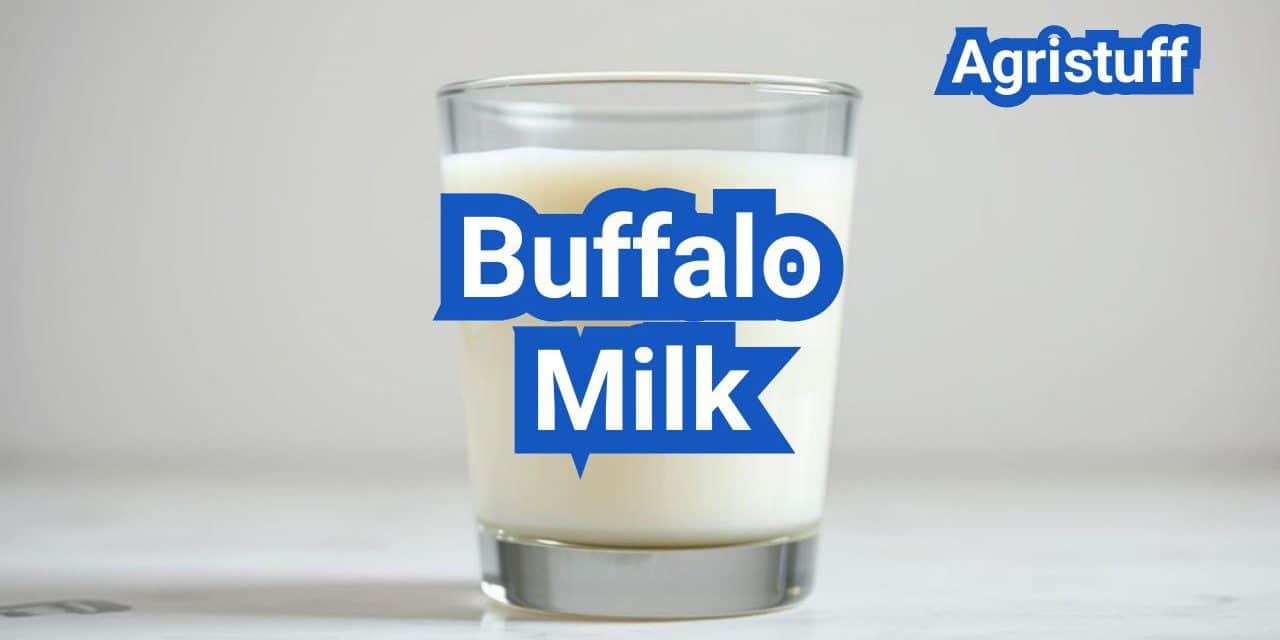Buffalo milk is gaining popularity in the United States due to its rich nutritional profile and unique taste. Compared to cow’s milk, it boasts 58% more calcium and 40% more protein, making it an attractive option for those seeking a healthier dairy alternative.
The nutritional benefits of buffalo milk extend beyond its high calcium and protein content. It also contains 43% less cholesterol than cow’s milk and is a rich source of iron, phosphorus, and vitamin A.
As consumers become more health-conscious, the demand for buffalo milk is on the rise. This introduction provides an overview of buffalo milk’s composition, its distinct taste, and where to find it in the U.S.
Key Takeaways
- Buffalo milk has a richer nutritional profile compared to cow’s milk.
- It contains 58% more calcium and 40% more protein.
- Buffalo milk has 43% less cholesterol than cow’s milk.
- It is a rich source of iron, phosphorus, and vitamin A.
- The demand for buffalo milk is increasing due to its health benefits.
What Is Buffalo Milk?
Water buffalo milk, known for its rich nutritional profile, has been consumed for centuries in many parts of the world. Unlike cow milk, buffalo milk has a distinct composition that makes it highly valued for its nutritional benefits and culinary uses.
Origin and History of Water Buffalo Dairy
The domestication of water buffalo dates back to ancient times, with evidence suggesting that they were first domesticated in the Indus Valley Civilization around 4000 BCE. The dairy from these animals became an integral part of the diet in many regions, particularly in South Asia and the Mediterranean.
Water Buffalo vs. American Bison
It’s essential to distinguish between water buffalo and American bison, as they are often confused due to their similar names. Water buffalo are primarily used for dairy and are found in various parts of the world, including Asia and Europe. In contrast, American bison, also known as American buffalo, are native to North America and are not typically used for dairy production.
Global Significance of Buffalo Milk
Buffalo milk is a significant source of nutrition globally, particularly in countries like India, Pakistan, and Italy. In these regions, buffalo milk is not only consumed directly but also used to produce various dairy products, such as cheese and yogurt. The global demand for buffalo milk products is on the rise due to their nutritional benefits and unique taste.
The unique characteristics of buffalo milk make it a valuable resource in the dairy industry. As consumers become more aware of its benefits, the demand for buffalo milk and its products is likely to continue growing.
Buffalo Milk Composition and Nutritional Profile
With its high fat content and rich protein structure, buffalo milk is considered a nutritious dairy option. Buffalo milk has been a staple in many cultures, particularly in regions where water buffalo are commonly found. Its nutritional profile is one of the key reasons it is preferred for producing various dairy products.
Fat Content and Composition
Buffalo milk contains a higher fat content compared to cow’s milk, with approximately 8g of fat per 100g. This high fat content contributes to its rich and creamy texture, making it ideal for producing cheese and butter. The fat in buffalo milk is also composed of various fatty acids, which are essential for nutritional purposes.
Protein Structure and Content
The protein content in buffalo milk is another significant aspect of its nutritional profile. It contains a substantial amount of protein, making it beneficial for those looking to increase their protein intake. The protein structure in buffalo milk is also known for its high quality, contributing to its digestibility and nutritional value.
Calcium and Mineral Content
Buffalo milk is rich in calcium and other essential minerals, which are vital for bone health and other bodily functions. The calcium content in buffalo milk is particularly noteworthy, as it supports the development and maintenance of strong bones and teeth.
Caloric Value and Lactose Content
In terms of caloric value, buffalo milk is relatively high due to its fat content, with approximately 97 calories per 100g. It also contains lactose, a sugar found in milk, although the lactose content is relatively moderate. Understanding the caloric and lactose content is crucial for consumers who are monitoring their diet or managing lactose intolerance.
Overall, the nutritional profile of buffalo milk makes it a valuable addition to a balanced diet, offering a rich source of fats, proteins, calcium, and other minerals.
The Distinctive Taste of Buffalo Milk
The rich, creamy taste of buffalo milk is attributed to its high fat content and unique nutritional profile. Buffalo milk has a luxurious taste experience that is distinct from cow’s milk, making it a sought-after ingredient in various culinary applications.
Flavor Profile and Characteristics
Buffalo milk’s flavor profile is characterized by its richness and depth, which can be attributed to its higher fat content compared to cow’s milk. The taste is often described as creamy and velvety, making it an ideal choice for producing high-quality dairy products.
Creaminess and Texture
The creaminess of buffalo milk is one of its most distinctive features. The higher fat content not only contributes to its rich taste but also gives it a smooth, velvety texture. This makes buffalo milk an excellent choice for desserts and other recipes where a creamy texture is desired.
Culinary Applications Based on Taste
Due to its unique taste and texture, buffalo milk is used in a variety of culinary applications. It is particularly popular in the production of authentic mozzarella cheese and other dairy products where its rich flavor can be showcased. Chefs and food enthusiasts appreciate buffalo milk for its versatility in both sweet and savory dishes.
In conclusion, the distinctive taste of buffalo milk, with its rich flavor profile and creamy texture, makes it a valuable ingredient in many culinary contexts. Its unique characteristics set it apart from other types of milk, offering a luxurious taste experience that is hard to match.
Buffalo Milk vs. Cow Milk: Key Differences

Understanding the differences between buffalo milk and cow milk is crucial for consumers making informed choices about their dairy intake. While both types of milk have their own set of benefits and drawbacks, they vary significantly in terms of nutritional content, taste, and production processes.
Nutritional Comparison
Buffalo milk generally has a higher nutritional value compared to cow milk. It contains more protein, calcium, and minerals, making it a preferred choice for those seeking a more robust dairy option.
| Nutritional Component | Buffalo Milk | Cow Milk |
|---|---|---|
| Protein Content | 4.5% | 3.5% |
| Fat Content | 8% | 3.5% |
| Calcium Content | 210 mg/100ml | 120 mg/100ml |
Taste and Texture Differences
The taste and texture of buffalo milk are distinct from cow milk, primarily due to its higher fat content. Buffalo milk has a richer, creamier texture, which is often preferred for making cheeses and other dairy products.
Digestibility Factors
Digestibility is another area where buffalo milk and cow milk differ. Buffalo milk contains the A2 type of beta-casein protein, which some research suggests may be easier to digest for individuals with sensitivities to A1 protein found in cow milk.
Production Efficiency
Production efficiency varies between buffalo and cow milk due to differences in milking processes and the lactation periods of the animals. Buffalo milk production is generally less efficient than cow milk, contributing to its higher cost.
In conclusion, the choice between buffalo milk and cow milk depends on individual nutritional needs, taste preferences, and budget considerations. By understanding the key differences, consumers can make more informed decisions about their dairy consumption.
The A2 Protein Advantage of Buffalo Milk
Unlike cow’s milk, which contains A1 protein, buffalo milk is rich in A2 protein, making it easier to digest. This distinction is crucial for individuals who experience discomfort or digestive issues with traditional cow’s milk.
Understanding A1 vs. A2 Protein
The primary difference between A1 and A2 protein lies in their amino acid structure. A1 protein contains histidine, while A2 protein contains proline. This difference affects how the proteins are broken down in the body.
A1 protein is known to release beta-casomorphin-7 (BCM-7) during digestion, which can cause gastrointestinal discomfort in some individuals. On the other hand, A2 protein does not release BCM-7, potentially making it a better option for those with sensitive stomachs.
Health Implications of A2 Milk
The health implications of consuming A2 milk, such as buffalo milk, are significant. Research suggests that A2 milk may reduce the risk of certain gastrointestinal disorders and improve overall digestive health.
- Reduced symptoms of irritable bowel syndrome (IBS)
- Lower risk of digestive discomfort
- Potential benefits for individuals with milk intolerance
Research on Digestive Benefits
Studies have shown that A2 milk can have a positive impact on digestive health. A key study found that participants who consumed A2 milk experienced reduced gastrointestinal symptoms compared to those who consumed A1 milk.
The growing body of research supporting the digestive benefits of A2 milk has significant implications for consumers looking for dairy options that are easier on the stomach.
Health Benefits of Buffalo Milk

Rich in nutrients, buffalo milk offers several advantages for overall health. Its unique composition makes it a valuable addition to a healthy diet.
Improved Digestibility
Buffalo milk contains A2 beta-casein protein, which is easier to digest compared to the A1 protein found in cow’s milk. This characteristic makes buffalo milk a good option for those who experience discomfort or intolerance to regular milk.
The digestive benefits of buffalo milk are attributed to its protein structure, which is closer to human milk. This similarity can make it more comfortable for consumption, especially for individuals with sensitive stomachs.
Higher Nutritional Value
Buffalo milk is renowned for its high nutritional content, including higher levels of calcium, protein, and vitamins compared to cow’s milk. This rich nutritional profile supports bone health and overall well-being.
| Nutrient | Buffalo Milk | Cow’s Milk |
|---|---|---|
| Calcium (mg/L) | 2100 | 1200 |
| Protein (%) | 4.5 | 3.2 |
| Fat (%) | 8 | 3.5 |
Potential Allergy Considerations
While buffalo milk is considered easier to digest for many, allergic reactions can still occur. Individuals with milk allergies should consult healthcare professionals before consuming buffalo milk products.
Immune System Support
The high content of lysozyme and immunoglobulins in buffalo milk contributes to its immune-boosting properties. These components help protect against infections and support the body’s immune response.
Incorporating buffalo milk into your diet can provide numerous health benefits, from improved digestibility to enhanced nutritional intake. As with any dietary change, it’s essential to consider individual needs and potential allergy considerations.
How to Incorporate Buffalo Milk Into Your Diet

Incorporating buffalo milk into your diet can be a game-changer for those looking to diversify their nutritional intake. With its rich nutritional profile and versatility in cooking, buffalo milk offers a range of health benefits and culinary possibilities.
Substituting Buffalo Milk in Daily Use
One of the simplest ways to incorporate buffalo milk into your diet is by substituting it for cow’s milk in your daily routines. Buffalo milk can be used in cereal, coffee, or as a beverage on its own. Its creamy texture and rich flavor make it a satisfying alternative.
When substituting, start by replacing cow’s milk with buffalo milk in small increments to adjust to its unique taste and texture.
Adjusting Recipes for Buffalo Milk
Buffalo milk’s higher fat content and richer flavor make it ideal for various recipes. When adjusting recipes, consider reducing the amount of sugar or salt due to its natural sweetness and flavor.
For example, buffalo milk is perfect for making creamy desserts like puddings or custards. It can also be used to make cheese, yogurt, and ice cream, offering a richer taste than traditional cow’s milk products.
Recommended Daily Consumption
While buffalo milk is nutritious, moderation is key due to its high calorie and fat content. A recommended daily consumption could be around 1-2 cups, depending on individual calorie needs and dietary goals.
| Daily Consumption | Caloric Intake | Nutritional Benefits |
|---|---|---|
| 1 cup | Approx. 170 calories | High in protein, calcium, and vitamins |
| 2 cups | Approx. 340 calories | Enhanced nutritional benefits, supports bone health |
By incorporating buffalo milk into your diet thoughtfully, you can enjoy its nutritional benefits while exploring new culinary delights.
Buffalo Milk Products You Should Try

The rich flavor and nutritional profile of buffalo milk make it an ideal ingredient for various dairy products. Buffalo milk is used to create a range of delicious and nutritious products that are worth trying.
Authentic Mozzarella di Bufala
Mozzarella di Bufala is one of the most famous buffalo milk products, originating from Italy. It’s made from the milk of water buffalo and is known for its creamy texture and rich flavor. This cheese is a staple in Italian cuisine, particularly in pizzas and caprese salads.
“Mozzarella di Bufala is a game-changer in the world of cheese. Its creamy texture and rich flavor elevate any dish it’s used in.”
Chef Giovanni, Italy
Other Buffalo Milk Cheeses
Apart from Mozzarella di Bufala, buffalo milk is used to produce other types of cheese, such as ricotta and scamorza. These cheeses are rich in flavor and have a unique texture that makes them perfect for various culinary applications.
| Cheese Type | Flavor Profile | Texture |
|---|---|---|
| Mozzarella di Bufala | Rich, creamy | Soft, elastic |
| Ricotta | Mild, slightly sweet | Soft, creamy |
| Scamorza | Smoky, slightly sweet | Soft, stringy |
Buffalo Milk Yogurt and Ice Cream
Buffalo milk is also used to make yogurt and ice cream, which are rich in protein and have a creamy texture. These products are perfect for those looking for a healthier dessert option or a nutritious snack.
Specialty Buffalo Milk Products
In addition to cheese, yogurt, and ice cream, buffalo milk is used to create other specialty products, such as butter and ghee. These products are rich in flavor and have a unique nutritional profile that makes them worth trying.
In conclusion, buffalo milk products offer a range of flavors and textures that are worth exploring. From authentic Mozzarella di Bufala to other cheeses, yogurt, and ice cream, there’s something for everyone.
Water Buffalo Farming in the United States

Water buffalo farming in the U.S. has evolved significantly, embracing sustainable practices and expanding its dairy offerings. This growth is driven by the increasing demand for buffalo milk and its products, known for their nutritional benefits and unique taste.
History of Buffalo Farming in the U.S.
The introduction of water buffalo to the United States dates back to the late 19th century, but it wasn’t until recent decades that buffalo farming began to gain momentum. Initially, water buffalo were brought in for their meat and labor, but the focus has shifted towards dairy production due to the high quality of their milk.
Current State of the Industry
Today, water buffalo farming is a growing industry in the U.S., with many farms adopting sustainable practices. These practices not only improve the welfare of the buffalo but also contribute to environmental conservation. The industry is supported by advancements in farming techniques and a growing market for buffalo milk products.
Sustainable Farming Practices
Sustainable farming practices are at the forefront of the U.S. water buffalo farming industry. Farms are implementing rotational grazing, reducing waste, and improving living conditions for the buffalo. These practices enhance the quality of the milk and contribute to the overall sustainability of the farm.
Notable American Buffalo Farms
Several notable farms across the United States are leading the way in water buffalo farming. These include farms that specialize in dairy production, offering high-quality buffalo milk and products such as mozzarella cheese and yogurt. Some of these farms also focus on educating consumers about the benefits of buffalo milk and promoting sustainable farming practices.
Key aspects of successful water buffalo farming in the U.S. include:
- Adoption of sustainable farming practices
- Focus on high-quality dairy production
- Education and promotion of buffalo milk benefits
- Innovation in products derived from buffalo milk
Where to Buy Buffalo Milk in the U.S.

Discovering where to buy buffalo milk is the first step in enjoying its numerous health benefits. Buffalo milk is becoming increasingly popular due to its rich nutritional profile and potential digestive benefits. If you’re looking to incorporate this dairy product into your diet, there are several options to consider.
Specialty Grocery Stores
Many specialty grocery stores now carry buffalo milk due to its growing demand. Stores that focus on gourmet or international products are more likely to stock buffalo milk. Some notable chains include Whole Foods, Trader Joe’s, and gourmet food stores in larger cities. When shopping at these stores, check the dairy section or ask a store representative for availability.
Farmers Markets
Farmers markets are an excellent place to find buffalo milk, especially those that specialize in local dairy products. Visiting a farmers market allows you to purchase directly from the producers and inquire about the milk’s production process. Many farmers are happy to share information about their farming practices and the benefits of their products.
Online Retailers
The rise of online shopping has made it easier to buy buffalo milk from the comfort of your home. Several online retailers specialize in dairy products, including buffalo milk. Some popular online stores include Amazon, Walmart, and specialty food websites. Be sure to check the product description, shipping policies, and customer reviews before making a purchase.
Direct from Farms
Buying buffalo milk directly from farms is another viable option. Many farms now offer online ordering and shipping or allow customers to pick up their products at the farm. This method ensures that you receive fresh, high-quality milk while supporting local agriculture. You can find local buffalo farms through online directories or by contacting local dairy associations.
| Source | Advantages | Considerations |
|---|---|---|
| Specialty Grocery Stores | Convenient, wide availability | May have limited supply, higher prices |
| Farmers Markets | Direct from producers, fresh products | Limited by location and market days |
| Online Retailers | Convenient, wide selection, customer reviews | Shipping costs, potential quality issues |
| Direct from Farms | Fresh, high-quality, supports local farms | May require minimum purchase, shipping logistics |
By exploring these options, you can easily find a reliable source for buffalo milk and enjoy its rich nutritional benefits. Whether you prefer the convenience of online shopping or the personal touch of buying directly from a farm, there’s a purchasing method that suits your needs.
How to Store and Handle Buffalo Milk

To enjoy the numerous benefits of buffalo milk, it’s essential to store and handle it correctly. Buffalo milk, with its rich nutritional profile, requires careful handling to maintain its quality.
Proper Storage Techniques
Buffalo milk should be stored in the refrigerator at a temperature below 40°F (4°C). It’s best to keep it in its original container or transfer it to a clean, airtight glass container to prevent contamination and exposure to air. Always check the container for any signs of damage or leakage before storing.
Shelf Life Considerations
The shelf life of buffalo milk varies depending on whether it’s raw or pasteurized. Generally, pasteurized buffalo milk can last up to 7-10 days when stored properly in the refrigerator. Raw buffalo milk, however, is more perishable and should be consumed within 3-5 days.
Signs of Spoilage
Before consuming buffalo milk, it’s crucial to check for signs of spoilage. These include an off smell, slimy texture, or an unusual color. If you notice any of these signs, it’s best to discard the milk to avoid health risks.
Freezing Buffalo Milk
Buffalo milk can be frozen to extend its shelf life. Pour the milk into an airtight container, leaving some space for expansion, and store it in the freezer. Frozen buffalo milk is best used in cooking or making smoothies after thawing. The texture might change slightly after freezing, but it remains safe to consume.
Making Your Own Buffalo Milk Products at Home

Buffalo milk, known for its rich composition, can be used to create a variety of delicious products in the comfort of your own home. With its high nutritional value and unique taste, making buffalo milk products is a rewarding experience.
Simple Buffalo Milk Cheese Recipe
Making cheese from buffalo milk is a straightforward process that requires minimal equipment. To start, you’ll need buffalo milk, cheese cultures, and rennet. Heat the milk to 86°F (30°C), add the cultures, and let it sit for 45 minutes. Then, add rennet and wait for the milk to coagulate. Cut the curd, drain the whey, and shape the cheese.
Tips: Use a thermometer to ensure the correct temperature, and be gentle when cutting the curd to avoid losing cheese bits.
Buffalo Milk Yogurt Preparation
Creating yogurt from buffalo milk involves heating the milk to 180°F (82°C), then cooling it to 110°F (43°C) before adding a yogurt culture. Incubate the mixture at a warm temperature (around 100°F or 38°C) for 6-8 hours. The result is a thick, creamy yogurt rich in probiotics.
Note: Maintaining the right temperature during incubation is crucial for the yogurt to set properly.
Buffalo Milk Ice Cream
Buffalo milk ice cream is a decadent treat. Mix buffalo milk with cream, sugar, and a stabilizer like guar gum. Heat the mixture to 170°F (77°C), then chill it before churning in an ice cream maker. The high fat content in buffalo milk gives the ice cream a smooth texture.
Tips for Success
To ensure success when making buffalo milk products, always start with high-quality milk, maintain cleanliness, and follow recipes closely. Experimenting with flavors and ingredients can also lead to unique and delicious variations.
| Product | Key Ingredients | Preparation Time |
|---|---|---|
| Buffalo Milk Cheese | Buffalo milk, cheese cultures, rennet | 1-2 hours |
| Buffalo Milk Yogurt | Buffalo milk, yogurt culture | 8-10 hours |
| Buffalo Milk Ice Cream | Buffalo milk, cream, sugar, guar gum | 2-3 hours |
Embracing the Benefits of Buffalo Milk
Buffalo milk offers a unique combination of nutritional benefits and culinary delights, making it an attractive alternative to traditional cow’s milk. With its rich buffalo milk nutrition profile, including higher calcium and protein content, it’s an excellent choice for those seeking a more wholesome dairy option.
The benefits of buffalo milk extend beyond its nutritional value, as it also provides potential health benefits, such as improved digestibility and immune system support. As consumers become more aware of the buffalo milk health benefits, its popularity is likely to grow.
For those interested in exploring the world of buffalo milk, there are numerous products available, from authentic Mozzarella di Bufala to specialty yogurts and ice creams. By incorporating buffalo milk into your diet, you can experience the rich flavors and nutritional benefits it has to offer.
FAQ
What is buffalo milk?
Buffalo milk is the milk produced by water buffalo, known for its rich nutritional profile and unique taste. It is used to make various dairy products, including mozzarella di bufala, cheese, yogurt, and ice cream.
How does buffalo milk differ from cow’s milk?
Buffalo milk has a higher fat content, richer nutritional profile, and different protein structure compared to cow’s milk. It is also known for its creamy texture and is often used in specialty dairy products.
What are the health benefits of buffalo milk?
Buffalo milk is rich in nutrients, including calcium, protein, and minerals. It is also known for its potential digestive benefits due to its A2 protein content, which may be easier to digest for some individuals compared to A1 protein found in cow’s milk.
Where can I buy buffalo milk in the U.S.?
Buffalo milk can be found in specialty grocery stores, farmers markets, and online retailers. Some farms also sell directly to consumers. Look for products labeled as “buffalo milk” or “water buffalo milk” to ensure authenticity.
How do I store buffalo milk?
Buffalo milk should be stored in the refrigerator at a temperature below 40°F (4°C). It is best consumed fresh, but it can be frozen for longer storage. Always check for signs of spoilage before consumption.
Can I make buffalo milk products at home?
Yes, you can make various buffalo milk products at home, including cheese, yogurt, and ice cream. There are many recipes available online that provide step-by-step instructions.
Is buffalo milk suitable for those with dairy allergies?
While buffalo milk is a dairy product, its protein structure and A2 protein content may make it more tolerable for some individuals with dairy sensitivities. However, it is not suitable for those with severe dairy allergies. Consult a healthcare professional for personalized advice.
What is A2 protein, and how does it benefit health?
A2 protein is a type of protein found in buffalo milk, known for its potential digestive benefits. Research suggests that A2 protein may be easier to digest than A1 protein, potentially reducing the risk of digestive discomfort in some individuals.
How is buffalo milk used in cooking and recipes?
Buffalo milk can be used in a variety of recipes, from savory dishes to desserts. Its rich flavor and creamy texture make it ideal for making creamy sauces, cheeses, and desserts like ice cream and custards.
Are there any notable buffalo farms in the U.S.?
Yes, there are several notable buffalo farms in the U.S. that produce high-quality buffalo milk and dairy products. Some of these farms are known for their sustainable practices and commitment to animal welfare.
Can buffalo milk be pasteurized?
Yes, buffalo milk can be pasteurized to kill harmful bacteria and extend its shelf life. Many commercial buffalo milk products are pasteurized, but some farms may sell raw buffalo milk directly to consumers.
Conclusion of: Buffalo Milk In USA
Buffalo Milk: What It Is and Why It’s Getting Attention in the U.S.
Buffalo milk is the rich, creamy milk produced by domestic water buffalo (Bubalus bubalis), a dairy animal widely used across South and Southeast Asia, parts of Europe, and Latin America, and it’s slowly finding curious fans in the U.S. for its distinct composition and culinary uses. — FAO on milk composition
Buffalo Milk vs. Cow’s Milk: The Big-Picture Differences
Buffalo milk generally carries substantially more total solids than cow’s milk—especially fat and protein—making buffalo milk naturally denser and creamier in texture. — FAO: composition comparison
Recent analytical work confirms these differences, reporting buffalo milk at roughly ~8–9% fat and ~5% protein (with total solids near ~20%), while cow’s milk often sits closer to ~4% fat and ~3–3.5% protein; lactose tends to be similar, meaning buffalo milk is richer yet not necessarily lower in milk sugar than cow’s milk. — MDPI Foods (2024) composition data
Why Buffalo Milk Looks So White
Many consumers notice that buffalo milk appears bright white; that’s because buffalo milk has little to no carotene (the yellow-orange pigment), converting much of it to colorless vitamin A, unlike typical cow’s milk, which retains more carotene and can look creamier yellow. — Springer: milk color & carotene
Beyond carotene, the microstructure matters too: bigger casein micelles and higher opacity in buffalo milk scatter light in a way that enhances the bright white appearance of buffalo milk. — Thermal processing review (Elsevier)
Buffalo Milk Nutrition: Fat, Protein, Lactose, and Minerals
Because buffalo milk is higher in fat and protein, a given cup delivers more calories and more building-block amino acids than a comparable cup of cow’s milk, so buffalo milk is often chosen where extra richness and yield matter in cheesemaking and desserts. — MDPI Foods (2024): higher fat & protein
Mineral-wise, literature repeatedly reports higher calcium and phosphorus in buffalo milk, which, along with a higher casein-to-protein ratio, helps explain why buffalo milk is famously good for stretching and setting into cheeses. — FAO: casein & minerals
If you track lactose for dietary reasons, studies show comparable lactose between buffalo milk and cow’s milk, so lactose-related tolerance issues can be similar for buffalo milk unless a product is specifically treated (e.g., lactase-added). — MDPI Foods (2024): lactose similarity
The “A2” Angle: What’s in the Casein of Buffalo Milk?
From a protein genetics perspective, buffalo milk contains the A2 form of β-casein by default, and research that genotyped hundreds of buffalo reported the A1 variant was absent—meaning buffalo milk is naturally an “A2” milk. — PubMed: buffalo milk is A2
While buffalo milk being A2 is interesting, keep in mind that clinical responses to dairy vary widely, and “A2” does not make buffalo milk suitable for anyone with a diagnosed milk allergy; if you’re sensitive, discuss buffalo milk with your clinician before experimenting. — NIH/PMC overview of A1/A2 hypothesis
Buffalo Milk and Cholesterol: What Do Studies Say?
Several analyses have found that buffalo milk fat can carry lower cholesterol levels than bovine milk fat when expressed per 100 g of milk or per 100 g fat, though ranges overlap by breed, diet, and measurement method; in practice, many consumers choose buffalo milk more for culinary performance than for cholesterol targets. — Lipid Health & Disease (2019): cholesterol figures
Because dietary cholesterol is only one part of a much larger heart-health picture, it’s sensible to consider overall diet quality and personal risk factors when deciding whether buffalo milk fits your routine. — NIH/PMC: composition context
How Buffalo Milk Tastes and Performs in the Kitchen
Cooks describe buffalo milk as clean, slightly sweet, and noticeably richer on the palate; the higher casein and fat in buffalo milk support exceptional stretch and glossy melt in fresh cheeses like mozzarella di bufala. — FAO: solids & cheesemaking suitability
Buffalo milk’s richness naturally shines in yogurt, kulfi, paneer, ice cream, and ghee, where the elevated fat and protein of buffalo milk translate into silkier textures and higher yields. — Brazilian J. Food Tech: buffalo milk in cheese
Is Buffalo Milk Easier on Lactose? What About Allergies?
Because lactose levels are similar across species, buffalo milk typically contains comparable milk sugar to cow’s milk; people with lactose intolerance will likely respond to buffalo milk similarly unless the product is lactose-free or fermented in ways that reduce lactose. — NIDDK: lactose intolerance
If you’re allergic to cow’s milk proteins, proceed with caution: reports show immunologic cross-reactivity among ruminant milks, so buffalo milk can still provoke reactions in people with cow’s milk allergy despite compositional differences. — Case report: buffalo/cow cross-reactivity
Buffalo Milk Safety and U.S. Regulations You Should Know
In the U.S., all milk (including buffalo milk) shipped across state lines for direct human consumption must be pasteurized; interstate sale of raw milk is prohibited under federal regulation, which shapes how buffalo milk products can be marketed. — FDA: interstate raw milk prohibition
Public-health agencies continue to document risks tied to raw milk; if you encounter raw buffalo milk via on-farm sales, understand the state-by-state legal landscape and the pathogen risks before purchasing. — CDC: raw milk risks
For processors, the Grade “A” Pasteurized Milk Ordinance sets sanitary standards for milk safety programs nationwide that apply the same backbone of controls whether the raw input is cow’s milk or buffalo milk. — FDA PMO (official PDF)
Where to Find Buffalo Milk (and Buffalo Dairy) in the U.S.
Fluid buffalo milk remains niche in the U.S., but you can increasingly find buffalo dairy in the form of cheese—especially mozzarella di bufala—at specialty counters; look for the protected-designation “Mozzarella di Bufala Campana” seal to ensure authentic production standards. — Consorzio di Tutela Mozzarella di Bufala Campana
If you prefer domestic sources, several small U.S. farms raise water buffalo and sell buffalo milk products regionally; browsing the American Water Buffalo Association can help you locate producers and learn what’s available in your area. — American Water Buffalo Association
When shopping online or in person, confirm that buffalo milk products are pasteurized (unless your state allows raw sales and you knowingly choose raw) and check dates and handling guidance just as you would with any perishable dairy. — CDC: perishable dairy safety
Buffalo Milk in Cheesemaking: Why It’s a Cheesemaker’s Favorite
The higher casein and calcium content of buffalo milk improve curd formation and yield, producing a tender, elastic matrix ideal for fresh-stretched cheeses, which is why mozzarella made from buffalo milk is globally prized. — FAO: casein & cheese yield
Nutrient profiles for buffalo mozzarella also reflect the richness of buffalo milk, with elevated protein and fat relative to many cow-milk counterparts, a point you’ll see on official producer-group nutrition materials. — Consorzio: nutrition facts for buffalo mozzarella
How to Use Buffalo Milk at Home
For cooking, buffalo milk behaves like an ultra-creamy whole milk: try buffalo milk for custards, kheer, rice pudding, or ice cream, where the extra fat and protein of buffalo milk translate into luxurious texture and stability. — MDPI Foods (2024): functional differences
If you’re mainly buying cheese, pair buffalo milk cheeses with tomatoes, basil, and olive oil for simple salads, or melt them onto pizza at lower oven temperatures to preserve the delicate, milky sweetness of buffalo milk. — Consorzio: product guidance
Buffalo Milk and U.S. Consumers: Practical Tips
Because buffalo milk is richer, mind portion sizes and storage: keep buffalo milk refrigerated at or below 40°F (4°C), observe sell-by/use-by dates, and treat buffalo milk products like any high-moisture dairy for food safety. — FDA: milk safety basics
If you have lactose intolerance, fermented buffalo milk products like yogurt or some aged cheeses may be gentler than fluid buffalo milk; however, responses vary, so introduce buffalo milk products slowly and observe how you feel. — NIDDK: lactose intolerance overview
Final thought
Buffalo milk is a distinctive, nutrient-dense dairy option that excels in cooking and cheesemaking, and while buffalo milk remains niche in the U.S., informed shoppers can find authentic products, understand safety rules, and enjoy the clean sweetness and lush texture that have made buffalo milk beloved around the world. — FAO: global context for buffalo milk
Sources & References
- FAO – Milk composition (species differences)
- MDPI Foods (2024) – Buffalo vs. Holstein milk composition (Table 2)
- Springer (2024) – Buffalo milk properties & color (carotene)
- NIH/PMC – Why milk is white (carotenoids & riboflavin)
- PubMed (2021) – Buffaloes carry A2A2 β-casein genotype
- Lipid in Health & Disease (2019) – Cholesterol in buffalo vs. cow milk
- Brazilian Journal of Food Technology – Buffalo milk in cheese
- Consorzio di Tutela Mozzarella di Bufala Campana – Product & nutrition
- FDA – Food Safety and Raw Milk (interstate prohibition)
- CDC – Raw milk risk overview | Raw milk in Agristuff
- FDA – Grade “A” Pasteurized Milk Ordinance (PMO)
- NIDDK – Lactose intolerance
- American Water Buffalo Association – Producers & info










